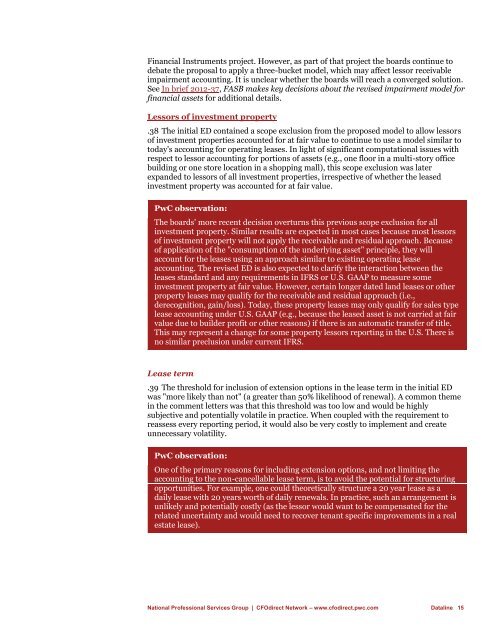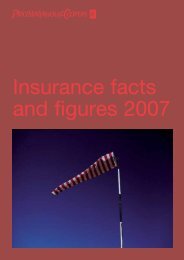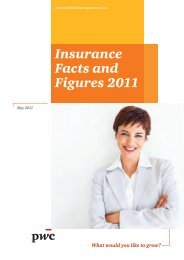Dataline A look at current financial reporting issues - PwC
Dataline A look at current financial reporting issues - PwC
Dataline A look at current financial reporting issues - PwC
You also want an ePaper? Increase the reach of your titles
YUMPU automatically turns print PDFs into web optimized ePapers that Google loves.
Financial Instruments project. However, as part of th<strong>at</strong> project the boards continue to<br />
deb<strong>at</strong>e the proposal to apply a three-bucket model, which may affect lessor receivable<br />
impairment accounting. It is unclear whether the boards will reach a converged solution.<br />
See In brief 2012-37, FASB makes key decisions about the revised impairment model for<br />
<strong>financial</strong> assets for additional details.<br />
Lessors of investment property<br />
.38 The initial ED contained a scope exclusion from the proposed model to allow lessors<br />
of investment properties accounted for <strong>at</strong> fair value to continue to use a model similar to<br />
today's accounting for oper<strong>at</strong>ing leases. In light of significant comput<strong>at</strong>ional <strong>issues</strong> with<br />
respect to lessor accounting for portions of assets (e.g., one floor in a multi-story office<br />
building or one store loc<strong>at</strong>ion in a shopping mall), this scope exclusion was l<strong>at</strong>er<br />
expanded to lessors of all investment properties, irrespective of whether the leased<br />
investment property was accounted for <strong>at</strong> fair value.<br />
<strong>PwC</strong> observ<strong>at</strong>ion:<br />
The boards' more recent decision overturns this previous scope exclusion for all<br />
investment property. Similar results are expected in most cases because most lessors<br />
of investment property will not apply the receivable and residual approach. Because<br />
of applic<strong>at</strong>ion of the "consumption of the underlying asset" principle, they will<br />
account for the leases using an approach similar to existing oper<strong>at</strong>ing lease<br />
accounting. The revised ED is also expected to clarify the interaction between the<br />
leases standard and any requirements in IFRS or U.S. GAAP to measure some<br />
investment property <strong>at</strong> fair value. However, certain longer d<strong>at</strong>ed land leases or other<br />
property leases may qualify for the receivable and residual approach (i.e.,<br />
derecognition, gain/loss). Today, these property leases may only qualify for sales type<br />
lease accounting under U.S. GAAP (e.g., because the leased asset is not carried <strong>at</strong> fair<br />
value due to builder profit or other reasons) if there is an autom<strong>at</strong>ic transfer of title.<br />
This may represent a change for some property lessors <strong>reporting</strong> in the U.S. There is<br />
no similar preclusion under <strong>current</strong> IFRS.<br />
Lease term<br />
.39 The threshold for inclusion of extension options in the lease term in the initial ED<br />
was "more likely than not" (a gre<strong>at</strong>er than 50% likelihood of renewal). A common theme<br />
in the comment letters was th<strong>at</strong> this threshold was too low and would be highly<br />
subjective and potentially vol<strong>at</strong>ile in practice. When coupled with the requirement to<br />
reassess every <strong>reporting</strong> period, it would also be very costly to implement and cre<strong>at</strong>e<br />
unnecessary vol<strong>at</strong>ility.<br />
<strong>PwC</strong> observ<strong>at</strong>ion:<br />
One of the primary reasons for including extension options, and not limiting the<br />
accounting to the non-cancellable lease term, is to avoid the potential for structuring<br />
opportunities. For example, one could theoretically structure a 20 year lease as a<br />
daily lease with 20 years worth of daily renewals. In practice, such an arrangement is<br />
unlikely and potentially costly (as the lessor would want to be compens<strong>at</strong>ed for the<br />
rel<strong>at</strong>ed uncertainty and would need to recover tenant specific improvements in a real<br />
est<strong>at</strong>e lease).<br />
N<strong>at</strong>ional Professional Services Group | CFOdirect Network – www.cfodirect.pwc.com <strong>D<strong>at</strong>aline</strong> 15

















